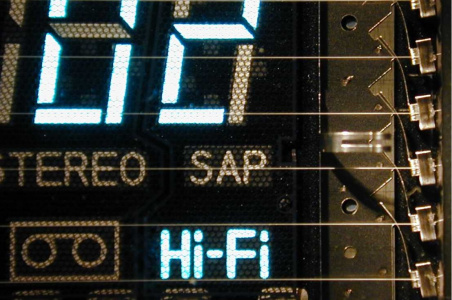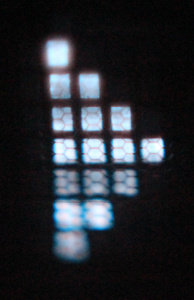Display types: Difference between revisions
m (→Self-lit) |
|||
| Line 51: | Line 51: | ||
===OLED=== | ===OLED=== | ||
<!-- | <!-- | ||
OLED are organic LEDs, which in itself party just a practical production detail, but really just LEDs. | |||
(...though you can get fancy in the production process, e.g. see-through display may be OLED with substate trickery{{verify}}) | |||
While OLED is also a thing in lighting, OLED ''usually'' comes up in the context of OLED displays, | |||
a variant of monitors where the display pixels themself emits light, | |||
rather than a backlight (most monitors are still backlit, which previously were side-lit with CCFL, and now commonly side-lit with LED). | |||
One of the largest upsides of such monitors is that you can get a pixel that produces no no light, | One of the largest upsides of such monitors is that you can get a pixel that produces no no light, | ||
in contrast with older screens that would block the backlight, but only ''mostly'' manage that. | |||
So the blacks are blacker. There are some other details why they tend to look crisper. | |||
| Line 73: | Line 77: | ||
"Doesn't LED | "Doesn't LED screen mean OLED?" | ||
No. "LED display" means LEDs were involved somehow. It can easily mean "we used a LED backlight instead of a CCFL" -- and the days, almost all LCD monitors are LED in this sense. | No. "LED display" means LEDs were involved somehow. It can easily mean "we used a LED backlight instead of a CCFL" -- and the days, almost all LCD monitors are LED in this sense. | ||
| Line 79: | Line 83: | ||
Marketing people ''really don't mind'' if you assume it's the same thing as OLED. | Marketing people ''really don't mind'' if you assume it's the same thing as OLED. | ||
You'll know when you have OLED, because it will | You'll know when you have OLED, because it will cost ten times as much - two thousand USD/EUR, more at TV sizes. | ||
The cost-benefit for the non-rich isn't there. | The cost-benefit for the non-rich isn't there. | ||
| Line 98: | Line 102: | ||
It's brighter, but they're still working on | It's brighter, but they're still working on details like decent contrast. | ||
Revision as of 12:27, 1 March 2024
Backlit flat-panel displays
There are roughly two parts of such monitors you can care about: How the backlight works, and how the pixels work.
CCFL or LED backlight
https://nl.wikipedia.org/wiki/CCFL
LCD/TFT/similar
Self-lit
OLED
QLED
On image persistence / burn-in
VFD
-
larger segments
-
dot matrix VFD
Vacuum Fluorescent Displays are vacuum tubes applied in a specific way - see Lightbulb_notes#VFDs for more details.
Lighting
Nixie tubes

Mechanical
Mechanical counter
https://en.wikipedia.org/wiki/Mechanical_counter
Split-flap

https://en.wikipedia.org/wiki/Split-flap_display
LED segments
7-segment and others

These are really just separate lights that happen to be arranged in a useful shape.
Very typically LEDs (with a common cathode or anode), though similar ideas are sometimes implemented in other display types - notably the electromechanical one, also sometimes VFD.
Even the simplest, 7-segment LED involves a bunch of connectors so are
- often driven multiplexed, so only one of them is on at a time.
- often done via a controller that handles that multiplexing for you
Seven segments are the minimal and classical case,
good enough to display numbers and so e.g. times, but not really for characters.
More-than-7-segment displays are preferred for that.
https://en.wikipedia.org/wiki/Seven-segment_display
DIY
LCD character dislays
Character displays are basically those with predefined (and occasionally rewritable) fonts.
Classical interface
The more barebones interface is often a 16 pin line with a pinout like
- Ground
- Vcc
- Contrast
- usually there's a (trim)pot from Vcc, or a resistor if it's fixed
- RS: Register Select (character or instruction)
- in instruction mode, it receives commands like 'clear display', 'move cursor',
- in character mode,
- RW: Read/Write
- tied to ground is write, which is usually the only thing you do
- ENable / clk (for writing)
- 8 data lines, but you can do most things over 4 of them
- backlight Vcc
- Backlight gnd
The minimal, write-only setup is:
- tie RW to ground
- connect RS, EN, D7, D6, D5, and D4 to digital outs
I2C and other
Matrix dislays
Small LCDs
These are sometimes incorrectly referred to OLED, which is a confusion with the small displays which are OLED (but usually monochrome).

